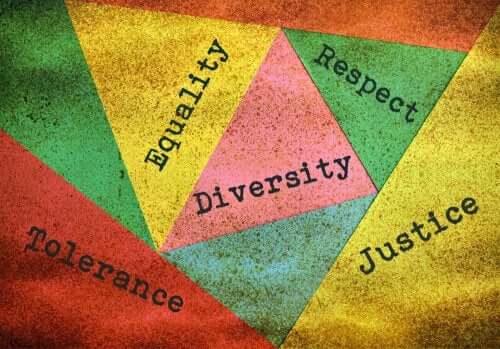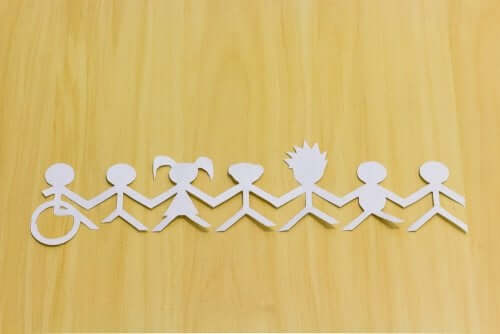How to Teach Children to be Inclusive

Today, society is aiming for the inclusion of all people. However, in order for that change to be long term, it’s important to start with the way we educate our youngest members. In other words, we need to teach our children to be inclusive.
Why is an inclusive society so important? What’s the goal of inclusion? Inclusion seeks to minimize or eliminate barriers that lead to the exclusion of certain individuals. It’s based on the conviction that diversity is an opportunity to enrich our culture.
“Diversity in the world is a basic characteristic of human society, and also the key condition for a lively and dynamic world as we see today.”
– Jintao Hu –
What does inclusion mean?
The European Union defines inclusion as follows:
“Social inclusion is a process which ensures that those at risk of poverty and social exclusion gain the opportunities and resources necessary to participate fully in economic, social and cultural life and to enjoy a standard of living and well-being that is considered normal in the society in which they live. It ensures that they have greater participation in decision making which affects their lives and access to their fundamental
right.”– European Union –

In short, you could say that inclusion is the quest for equality. In that sense, the three basic aspects of the construction and proper functioning of a society are the following:
- Collaboration.
- Participation.
- Cooperation.
At the same time, it’s important to carry out inclusion in two dimensions:
- Cultural: Building community and establishing inclusive values.
- Political: Developing inclusive practices and organizing the support of diversity.
“Inclusion is not bringing people into what already exists; it is making a new space, a better space for everyone.”
– George Dei –
How to teach children to be inclusive
Children need to learn to be inclusive from the time they’re very small. That way, they grow up assimilating the right ethical values without discriminating against anyone.
For this to happen, we need to teach them in practical ways. In other words, by utilizing games and activities for the development of personality, social abilities, inclusion, and positive coexistence among children.
What’s more, parents should act as good models that children can imitate. That means that, to teach our children to be inclusive, we need to show them, through our example, how to:
- Act socially without discriminating.
- Tolerate frustration.
- Accept diversity.
- Handle anger and stress.
At the same time, families are responsible for being careful about the language they use at home. And, when it comes to teaching our children to be inclusive, this means making our language as inclusive as possible.
We also have the responsibility of being careful about the messages that children receive from television, toys, video games, stories, etc. It’s our job to make sure they’re not learning negative behaviors and values.
Activities for teaching children to be inclusive
Sports activities
One of the measures that adults can take to teach children to be inclusive has to do with sports. By encouraging our little ones to participate in some sort of group or team sport, they’ll learn the following:
- Socialization.
- Respect for rules.
- How to win and lose.
- The acquisition of values that have to do with living harmoniously in society.

However, sports activities require the supervision of an adult. Otherwise, they can lead to violent behaviors that result from competitiveness between children. Therefore, teachers, coaches, or parents would be present to guide team sports.
Group dynamics
At the same time, to teach children to be inclusive, adults should use group dynamics. This means proposing games as an educational resource and as a means of socialization. In doing so, you create a fun environment and encourage the active development of participants.
What’s more, when designing your group activities, make sure that all kinds of children will be able to take part – regardless of their intellectual level or economic background. At the same time, you need to factor in the participation of children with disabilities, disorders, illness, etc.
In this sense, it’s important that you strive to prevent the isolation or rejection of any child for any reason. At the same time, encourage diversity through social interactions among small children, as this will help to create a more inclusive society today and in the future.
“When everyone is included, everyone wins.”
– Jesse Jackson –
Today, society is aiming for the inclusion of all people. However, in order for that change to be long term, it’s important to start with the way we educate our youngest members. In other words, we need to teach our children to be inclusive.
Why is an inclusive society so important? What’s the goal of inclusion? Inclusion seeks to minimize or eliminate barriers that lead to the exclusion of certain individuals. It’s based on the conviction that diversity is an opportunity to enrich our culture.
“Diversity in the world is a basic characteristic of human society, and also the key condition for a lively and dynamic world as we see today.”
– Jintao Hu –
What does inclusion mean?
The European Union defines inclusion as follows:
“Social inclusion is a process which ensures that those at risk of poverty and social exclusion gain the opportunities and resources necessary to participate fully in economic, social and cultural life and to enjoy a standard of living and well-being that is considered normal in the society in which they live. It ensures that they have greater participation in decision making which affects their lives and access to their fundamental
right.”– European Union –

In short, you could say that inclusion is the quest for equality. In that sense, the three basic aspects of the construction and proper functioning of a society are the following:
- Collaboration.
- Participation.
- Cooperation.
At the same time, it’s important to carry out inclusion in two dimensions:
- Cultural: Building community and establishing inclusive values.
- Political: Developing inclusive practices and organizing the support of diversity.
“Inclusion is not bringing people into what already exists; it is making a new space, a better space for everyone.”
– George Dei –
How to teach children to be inclusive
Children need to learn to be inclusive from the time they’re very small. That way, they grow up assimilating the right ethical values without discriminating against anyone.
For this to happen, we need to teach them in practical ways. In other words, by utilizing games and activities for the development of personality, social abilities, inclusion, and positive coexistence among children.
What’s more, parents should act as good models that children can imitate. That means that, to teach our children to be inclusive, we need to show them, through our example, how to:
- Act socially without discriminating.
- Tolerate frustration.
- Accept diversity.
- Handle anger and stress.
At the same time, families are responsible for being careful about the language they use at home. And, when it comes to teaching our children to be inclusive, this means making our language as inclusive as possible.
We also have the responsibility of being careful about the messages that children receive from television, toys, video games, stories, etc. It’s our job to make sure they’re not learning negative behaviors and values.
Activities for teaching children to be inclusive
Sports activities
One of the measures that adults can take to teach children to be inclusive has to do with sports. By encouraging our little ones to participate in some sort of group or team sport, they’ll learn the following:
- Socialization.
- Respect for rules.
- How to win and lose.
- The acquisition of values that have to do with living harmoniously in society.

However, sports activities require the supervision of an adult. Otherwise, they can lead to violent behaviors that result from competitiveness between children. Therefore, teachers, coaches, or parents would be present to guide team sports.
Group dynamics
At the same time, to teach children to be inclusive, adults should use group dynamics. This means proposing games as an educational resource and as a means of socialization. In doing so, you create a fun environment and encourage the active development of participants.
What’s more, when designing your group activities, make sure that all kinds of children will be able to take part – regardless of their intellectual level or economic background. At the same time, you need to factor in the participation of children with disabilities, disorders, illness, etc.
In this sense, it’s important that you strive to prevent the isolation or rejection of any child for any reason. At the same time, encourage diversity through social interactions among small children, as this will help to create a more inclusive society today and in the future.
“When everyone is included, everyone wins.”
– Jesse Jackson –
All cited sources were thoroughly reviewed by our team to ensure their quality, reliability, currency, and validity. The bibliography of this article was considered reliable and of academic or scientific accuracy.
- Burción, S. (2015). El recreo libre y el recreo dirigido. Comparación de conductas del alumnado para la mejora de la convivencia. (Trabajo de Fin de Grado). Universidad de Valladolid, España.
- FEVAS Plena Inclusión. (2010). Guía de materiales para la inclusión educativa: discapacidad intelectual y del desarrollo. Educación Primaria. Bilbao: Federación Vasca de Asociaciones en favor a las personas con discapacidad intelectual.
This text is provided for informational purposes only and does not replace consultation with a professional. If in doubt, consult your specialist.








